Time To Fly! ("Right Rudder!")
by ANN Managing Editor Rob Finfrock
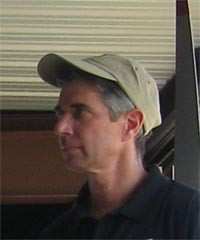 "I'll go ahead and
handle the first takeoff. Follow me along on the controls," my
instructor, Jim Crone (right), told me. It was 10:15 in the morning
of March 25, a bright and sunny day south of Green Cove Springs...
and my flight training in the Gobosh 700S was about to begin.
"I'll go ahead and
handle the first takeoff. Follow me along on the controls," my
instructor, Jim Crone (right), told me. It was 10:15 in the morning
of March 25, a bright and sunny day south of Green Cove Springs...
and my flight training in the Gobosh 700S was about to begin.
At this point, I'd known Jim for all of about 16 hours -- but I
was already impressed with his knowledge, and his easy-going
nature. With more years of flight experience -- much of it as an
instructor -- than I've been in existence ("it's been either 34 or
35 years," he'd told me during an earlier phone conversation) Jim
had already taught me some new things... and all we'd done so far
is preflight the aircraft, start it up, and back-taxi down the
grass runway.
At the top of that list was how to deal with a free-castering
nosewheel -- a new experience for me. I'd made a mess of taxiing
N702GB when I first flew this airplane, at AirVenture last year on
a demo flight out of Fond-du-lac.
My efforts to keep the plane in a straight line on the ground
then looked more like a pinball game; I was doing much better this
time around... after Jim showed me how to lead with the brake, but
not to ride it. Perhaps the added resistance of the grass is
helping me keep it in a straight line, too, I thought.
Jim advanced the throttle, and the Gobosh started rolling
down Haller's 2,600-foot grass strip. I'd like to say I
noticed how much right rudder Jim had in as we approached rotation
speed... but my mind was mostly preoccupied with how fast we were
advancing towards the tree line at the end of the runway. Of
course, we were off the ground and climbing out, well in advance of
the local flora being of concern.
Two left turns onto downwind, and we were heading south to
Palatka (28J) for fuel. It was a somewhat bumpy day, but I was
doing a fairly good job of keeping us straight, level, and
on-course. I mentally patted myself on the back; I'd last flown an
airplane -- this one, in fact -- eight months ago.
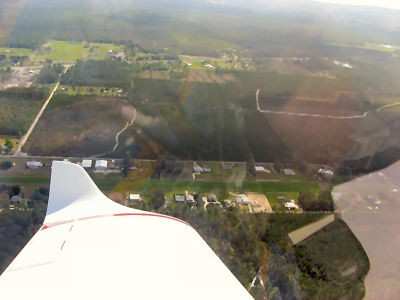
The traffic pattern at Palatka was a little busy, with two other
aircraft in the pattern for Runway 9. We entered at midfield, with
Jim leading me through the proper steps to landing. I knew he was
testing my skills, to see how much "rust" was on them. As it turned
out, it was a fair amount; I was 10 knots too fast on downwind, and
100 feet low; and my turn to base was late.
Still, by the time we were on the (too long) final, I had things
configured nicely. Okay. Time to impress the guy. We
crossed the threshold at 55 knots, in a beautiful (if I say so
myself) descent. Once I got the "picture" I was looking for --
of how the nose looked ahead, relative to the end of the runway --
I flared gently...
... And bounced the nose off the pavement with a decided
smack. A quick blip of the throttle -- provided by Jim --
lifted us into the air, and allowed us to settle back onto the
runway in a more-controlled fashion.
As I zig-zagged the plane towards the fuel pumps (sure enough,
taxiing was harder to do on pavement than it was on grass) Jim
offered his take on what happened.
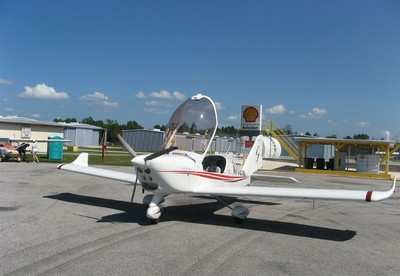
"This plane sits nose-high," he said, gesturing towards the
cowling. "Not taildragger-high, but more so than a lot of other
tricycle-gear planes. If you're used to flying a Cessna or
something like that, the sightlines are going to be a lot different
than you're used to. If you'd raised the nose just a bit higher,
you'd have had that landing made."
After fueling up at Palatka's self-service pumps (at $3.99 a
gallon!) we started up and taxied back to the runway. I was looking
for nothing short of redemption; a nice, smooth takeoff would do
nicely.
"This plane takes a LOT of right rudder on takeoff," Jim told me
as I drove us onto the runway. "You have to stand on the pedal
from the moment you advance the throttle. I'll follow along with
you, of course."
He wasn't kidding. The Gobosh immediately veered left the moment
I applied takeoff power, and it took all the right leg I had to
keep us straight. I even had to cheat a little, pushing in the
right brake a bit until we had enough speed to make the rudder
fully effective.
And then came the rotation. The Gobosh's stabilator tail raised
the nose abruptly in response to what I thought was just a small
amount of back pressure, resulting in the first two seconds of our
ascent into the Florida skies being accompanied by the stall horn.
(Even worse, I had made a similarly-awkward takeoff back at
Fond-du-lac, too.) I lowered the nose just enough to gain speed...
which then came quickly, requiring what felt like an unnaturally
nose-high attitude to keep us from exceeding 60 knots.

"I swear to God, Jim, I know how to fly!" I said as we climbed
straight out, over the St. John's River.
"No problem," he responded. "Hey, you're rusty. Happens to all
of us."
Once we were over the practice area east of the river, Jim led
me through a basic refresher course of maneuvering flight:
turns-around-a-point, forward-and-side-slips, descending and
climbing turns, and pilotage. After I got a "feel" for the
plane, everything was fairly effortless; I was beginning
to feel my piloting mojo return, and Jim agreed.
"All those maneuvers were to checkride standards," he told me.
"See? You remember how to fly!"
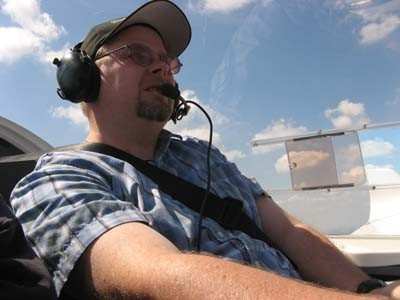
My confidence was bolstered by another discovery, too. As I
suspected during my earlier "sim" training, it's tough to miss
Palatka -- since two large smokestacks rise over the flat land,
visible for miles around, and the airport lies just southwest of
those stacks. Although I was flying over a completely unfamiliar
area and terrain, I was comforted by knowing I'd have little
trouble finding the airport.
After 1.3 hours of pretty intense airwork, we returned to
Palatka -- my landing this time wasn't a bouncer, but it was a
three-pointer -- and borrowed the FBO courtesy car to grab a quick
lunch. Since I still had to post afternoon stories on ANN, we took
off to return to Haller afterwards.

This time around, my takeoff was slightly better; we still
veered a bit down the runway, but I had the proper takeoff attitude
this time, and the stall horn remained quiet.
As we bounced our way back to Haller -- thanks to turbulence
brought on by the warming of the ground, and residual breezes -- I
contemplated the task ahead of me. This would be my first-ever
soft-field landing, on a short, grass landing strip. I was nervous
about that... even going so far as to tell Jim I was willing to sit
back and watch him do it.
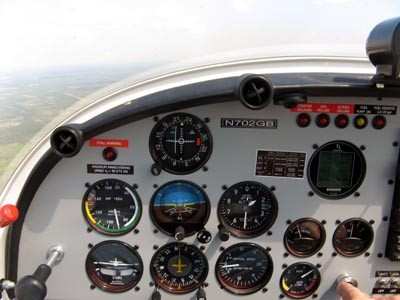
"Well, I can, but why don't you try it?" he responded. "I'm here
if you need me, but you might surprise yourself."
I gulped. Before now, the shortest runway I'd ever landed on was
the 4,000-foot asphalt strip at Grand Prairie... and that runway
didn't have trees on all sides. At least we'd be making a
straight-in approach, as the winds favored landing to the north.
Still, my heart was in my throat as we descended... and it raced as
I noticed our descent below the tree line out the corner of my
eye.
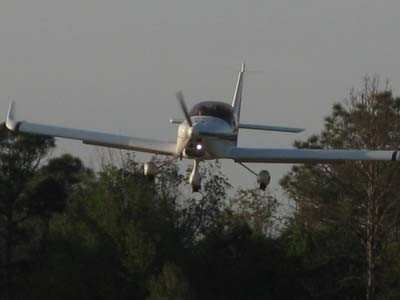
Surprisingly -- well, to me anyway, if not Jim -- I made an
unassisted, spot-on landing at Haller. I even flared properly...
and remembered to keep back pressure in throughout the rollout to
keep the nose light on the soft ground. For the first time all day,
I felt like a pilot.
"You're going to do fine on grass," Jim laughed. "And did you
notice you had a pretty stiff crosswind? But you kept us on track
fine. You're going to do fine on all of it."
****
After four hours of catching up on the latest goings-on in the
aviation world, it was time to fly again. This time, the wind
favored a takeoff to the south. I made a decent, not great,
takeoff; my right leg was already feeling a bit sore.
During the short flight down to 28J, Jim showed me how easy it
is to trim the airplane to fly at 60 knots -- on the edge of slow
flight, flaps up. "This is all you're doing in the pattern," he
reminded me, as I did a lazy 360-degree turn to the left. "This
little plane will fly all day at this speed."
Sure enough, my traffic pattern was much better this time
around. It also helped we were now the only plane in the pattern;
traffic had cleared out appreciably from the rather crowded state
earlier. 28J is VERY popular with student pilots from Daytona
Beach; apparently, they were now busy in ground school.

We did six landings, a mix of touch-and-goes and taxibacks.
After another one of my bouncy landings, Jim demonstrated a
high-speed taxi... with the nosegear high off the ground, in the
climbout attitude, using the rudder to keep us in a straight line
and power to keep the nose raised, but not so much that we took
off.
"Here's your flare attitude, too," he pointed out. "See how high
the nose looks?"
Jim then had me demonstrate a high-speed taxi. I didn't have the
heart to scrape the tailskid, as Jim had (note to Gobosh: this is
why N702GB's once-pristine tailskid is now scraped. I didn't do
it!)... but I did keep the nose high off the ground, and proved
able to work the rudder to keep us in a straight line. Things were
starting to come together.
After one more landing -- which was far better than the ones
that had preceded it, at least the ones on pavement -- we refueled
and headed back to Haller. By the time we landed at 7:15, I knew I
WAS making progress... and I capped it off with another nice
landing back at Haller.
Total time for the first day: 3.9 hours, with 11 takeoffs and,
fortunately, and equal number of landings, not counting
bouncers.
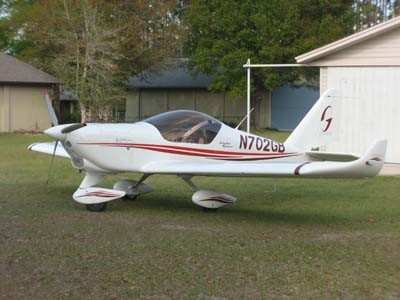
"How do you feel?" Jim asked me after we shut down. I grinned,
weary but relieved. "I'm loving every minute of it."
Coming Monday: Learning The Quirks Of N702GB
 ANN's Daily Aero-Linx (04.15.24)
ANN's Daily Aero-Linx (04.15.24) Classic Aero-TV: 'No Other Options' -- The Israeli Air Force's Danny Shapira
Classic Aero-TV: 'No Other Options' -- The Israeli Air Force's Danny Shapira Aero-News: Quote of the Day (04.15.24)
Aero-News: Quote of the Day (04.15.24) Airborne 04.16.24: RV Update, Affordable Flying Expo, Diamond Lil
Airborne 04.16.24: RV Update, Affordable Flying Expo, Diamond Lil ANN's Daily Aero-Term (04.16.24): Chart Supplement US
ANN's Daily Aero-Term (04.16.24): Chart Supplement US












